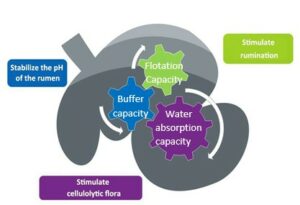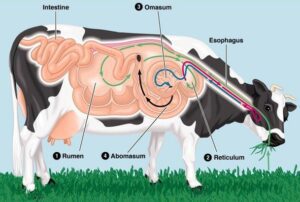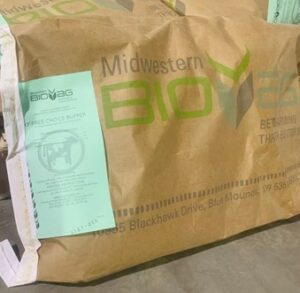
The Rumen
The rumen is found on the left side of the animal and holds around 130-200 liters. A healthy rumen will have two contractions per minute. To look for a healthy rumen, handlers must watch for regurgitation, re-chewing, and re-swallowing. This process is called rumination or cud-chewing. When observing cows chewing you should count at least 50 times per minute. If not there may be something wrong with the diet.
 The Rumination Process
The Rumination Process
As rumination proceeds, saliva is produced. A typical milking cow can produce 98 to 190 liters of saliva. One important role of saliva is to buffer the pH of the rumen. In other words, saliva contains bicarbonates that will help minimize the fluctuation of the pH in the rumen.
Rumen pH Recommendations
Rumen pH should be between 6.2 and 6.5 throughout a 24 hour period. The higher the level of concentrate in feeds, the more fluctuations there is in the pH and so there is an increased risk of sub-acute ruminal acidosis. Acidosis occurs when the pH of the rumen falls to less than 5.5.
Rumen Acidosis
Rumen acidosis is a metabolic disease in cattle. Firstly, the rumen stops moving, becoming atonic. This depresses appetite and production. Secondly, the change in acidity changes the rumen flora, which causes acid-producing bacteria to take over. They produce more acid, making the acidosis worse. The increased acid is then absorbed through the rumen wall, causing metabolic acidosis, which in severe cases can lead to shock and death.
The primary cause of acidosis is feeding high levels of rapidly digestible carbohydrates, such as barley and other cereals. Some signs of sub-acute acidosis include
- Reduced feed intake
- Poor body condition and weight loss
- Unexplained diarrhea
- Temperature
- Pulse rate and respiratory rate may rise
- Lethargy
Prevention of Acidosis
Properly balancing the fiber and non-fiber carbohydrates and excellent feed bunk management can prevent acidosis and maintain the pH of the rumen. Ruminant diets should also be formulated to provide adequate buffering. This can be accomplished by feedstuff selection and/or by the addition of dietary buffers such as bicarbonate or potassium carbonate. A healthy, balanced diet leads to a healthy rumen, which ultimately results in a healthy animal.
 Product of the Week: “O” Free Choice Buffer
Product of the Week: “O” Free Choice Buffer
Free Choice Buffer can be used in addition to sodium bicarbonate or as a sodium bicarbonate alternative to help improve rumen health and function.
-
-
-
-
-
-
-
-
- Contains calcium and magnesium sources with rumen buffering
- Provides clay-based buffers such as montmorillonite and bentonite.
- Contains yeast culture to help stabilize the rumen fermentation process.
- Serves as a highly palatable free-choice
-
-
-
-
-
-
-
LOOKING FOR SUPPORT WITH LIVESTOCK NUTRITION? CONNECT WITH ONE OF OUR CONSULTANTS



